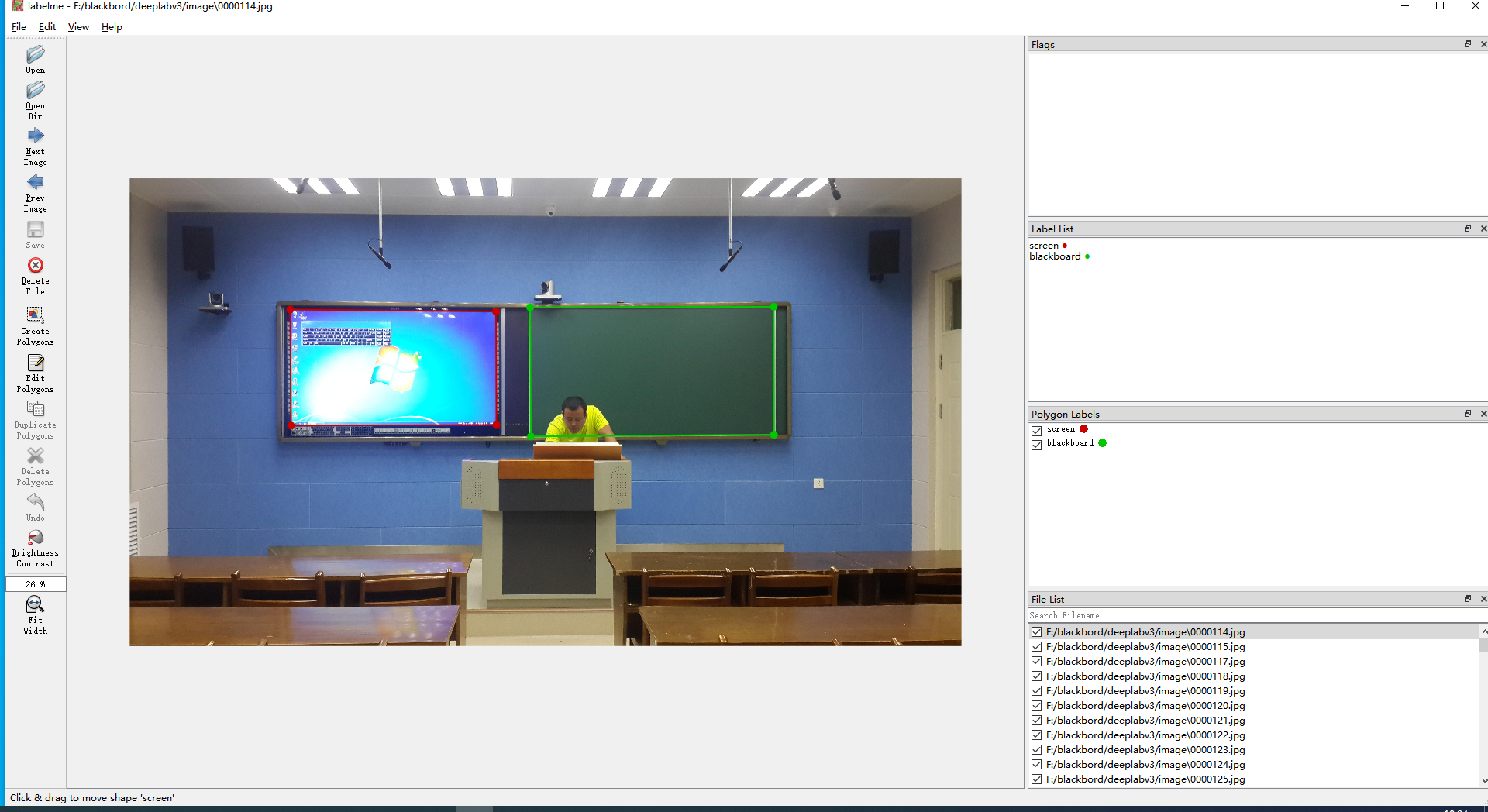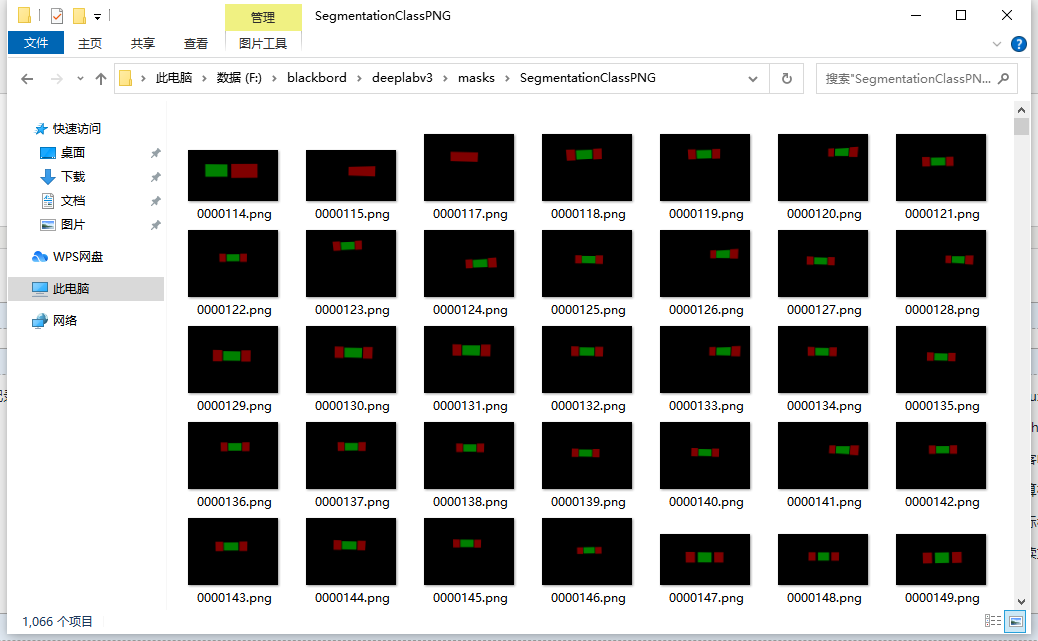一、数据标注
使用labelme,如下:

数据图片和标注json文件放到同一个目录下
二、图像标注后的数据转换
(1)训练数据集生成标签图
python labelme2voc.py F:lackborddeeplabv3image --labels labels.txt
__ignore__ _background_ blackboard screen
(2)代码如下
#!/usr/bin/env python from __future__ import print_function import argparse import glob import json import os import os.path as osp import sys import numpy as np import PIL.Image import labelme def main(): parser = argparse.ArgumentParser( formatter_class=argparse.ArgumentDefaultsHelpFormatter ) parser.add_argument('--input_dir', default= r"F:lackborddeeplabv3image",help='input annotated directory') parser.add_argument('--output_dir', default= r"F:lackborddeeplabv3masks",help='output dataset directory') parser.add_argument('--labels', default = r"F:lackborddeeplabv3class_label.txt",help='labels file', ) args = parser.parse_args() if osp.exists(args.output_dir): print('Output directory already exists:', args.output_dir) sys.exit(1) os.makedirs(args.output_dir) os.makedirs(osp.join(args.output_dir, 'JPEGImages')) os.makedirs(osp.join(args.output_dir, 'SegmentationClass')) os.makedirs(osp.join(args.output_dir, 'SegmentationClassPNG')) os.makedirs(osp.join(args.output_dir, 'SegmentationClassVisualization')) print('Creating dataset:', args.output_dir) class_names = [] class_name_to_id = {} for i, line in enumerate(open(args.labels).readlines()): class_id = i - 1 # starts with -1 class_name = line.strip() class_name_to_id[class_name] = class_id if class_id == -1: assert class_name == '__ignore__' continue elif class_id == 0: assert class_name == '_background_' class_names.append(class_name) class_names = tuple(class_names) print('class_names:', class_names) out_class_names_file = osp.join(args.output_dir, 'class_names.txt') with open(out_class_names_file, 'w') as f: f.writelines(' '.join(class_names)) print('Saved class_names:', out_class_names_file) colormap = labelme.utils.label_colormap(255) for label_file in glob.glob(osp.join(args.input_dir, '*.json')): print('Generating dataset from:', label_file) with open(label_file,"r",encoding="utf-8") as f: base = osp.splitext(osp.basename(label_file))[0] out_img_file = osp.join( args.output_dir, 'JPEGImages', base + '.jpg') out_lbl_file = osp.join( args.output_dir, 'SegmentationClass', base + '.npy') out_png_file = osp.join( args.output_dir, 'SegmentationClassPNG', base + '.png') out_viz_file = osp.join( args.output_dir, 'SegmentationClassVisualization', base + '.jpg', ) data = json.load(f) label_file = label_file.rstrip(".json") print(label_file) # img_file = osp.join(osp.dirname(label_file), data['imagePath']) img_file =label_file +".jpg" print(img_file) img = np.asarray(PIL.Image.open(img_file)) PIL.Image.fromarray(img).save(out_img_file) lbl = labelme.utils.shapes_to_label( img_shape=img.shape, shapes=data['shapes'], label_name_to_value=class_name_to_id, ) labelme.utils.lblsave(out_png_file, lbl) np.save(out_lbl_file, lbl) viz = labelme.utils.draw_label( lbl, img, class_names, colormap=colormap) PIL.Image.fromarray(viz).save(out_viz_file) if __name__ == '__main__': main()


(3) mask灰度值的转换:
python datasets/remove_gt_colormap.py --original_gt_folder /lwh/models/research/deeplab/datasets/blackboard/png --output_dir /lwh/models/research/deeplab/datasets/blackboard/mask
(4)制作指引文件,为生成tfrecord数据格式做准备
import os,shutil from PIL import Image train_path = r'F:lackborddeeplabv3masks rain' filelist_train = sorted(os.listdir(train_path)) val_path = r'F:lackborddeeplabv3masksval' filelist_val = sorted(os.listdir(val_path)) index_path = r'F:lackborddeeplabv3masksindex' VOC_file_dir = index_path VOC_train_file = open(os.path.join(VOC_file_dir, "train.txt"), 'w') VOC_test_file = open(os.path.join(VOC_file_dir, "val.txt"), 'w') VOC_train_file.close() VOC_test_file.close() VOC_train_file = open(os.path.join(VOC_file_dir, "train.txt"), 'a') VOC_test_file = open(os.path.join(VOC_file_dir, "val.txt"), 'a') for eachfile in filelist_train: (temp_name,temp_extention) = os.path.splitext(eachfile) img_name = temp_name VOC_train_file.write(img_name + ' ') for eachfile in filelist_val: (temp_name, temp_extention) = os.path.splitext(eachfile) img_name = temp_name VOC_test_file.write(img_name + ' ') VOC_train_file.close() VOC_test_file.close()
(4)制作tfrecord文件
需要四个文件路径

image存放原始的训练图片,index存放指引文件,mask存放去除水雾的label图片,tfrecord为保存训练数据,运行下面脚本命令,生成训练数据
python build_voc2012_data.py --image_folder="/lwh/models/research/deeplab/datasets/CamVid/image"
--semantic_segmentation_folder="/lwh/models/research/deeplab/datasets/CamVid/mask"
--list_folder="/lwh/models/research/deeplab/datasets/CamVid/index" --image_format="png" --label_format="png"
--output_dir="/lwh/models/research/deeplab/datasets/CamVid/tfrecord"